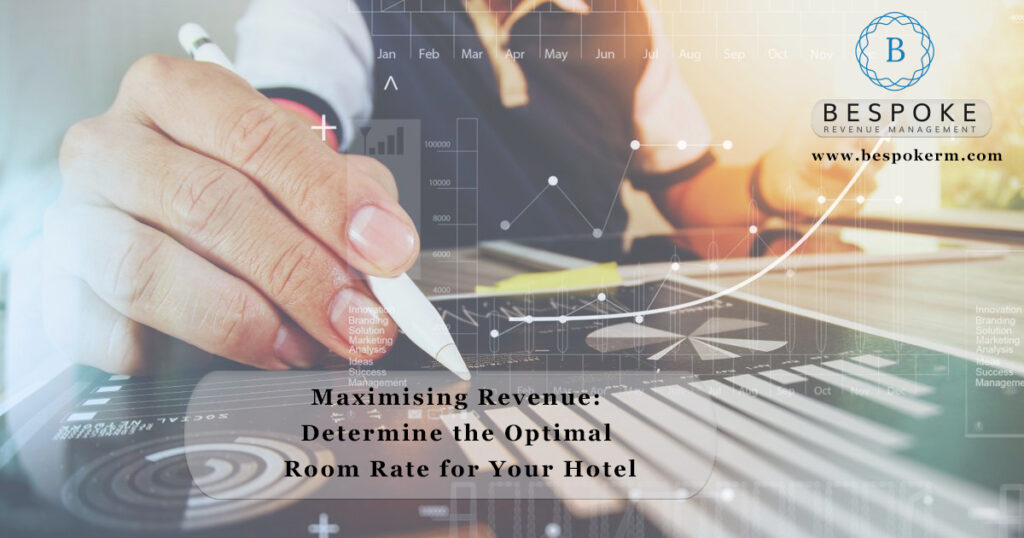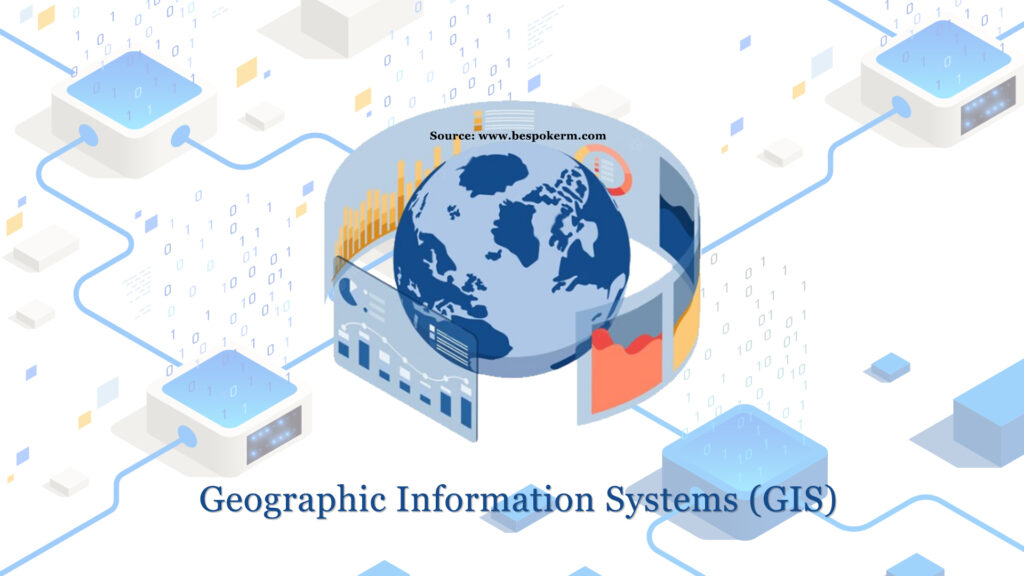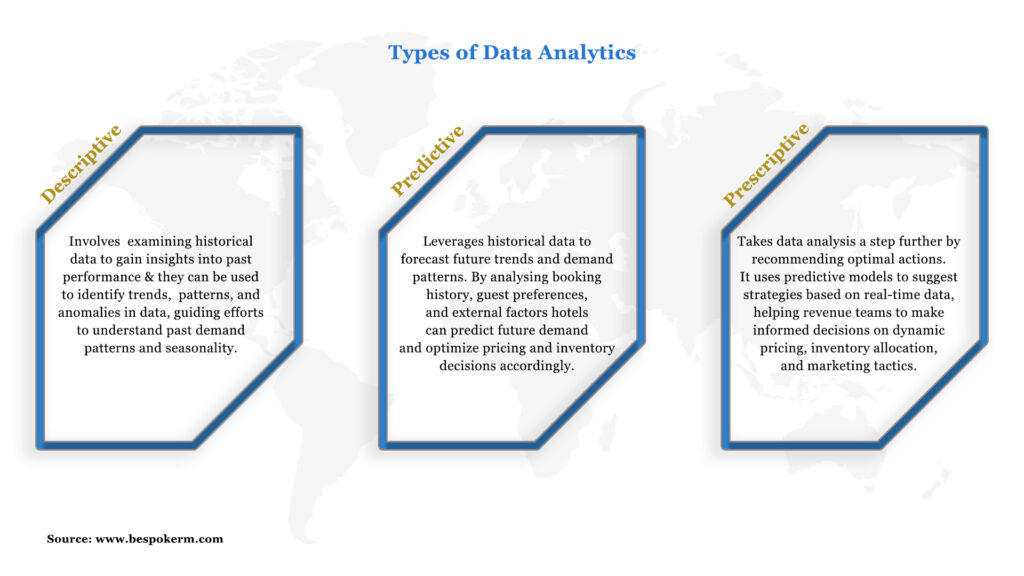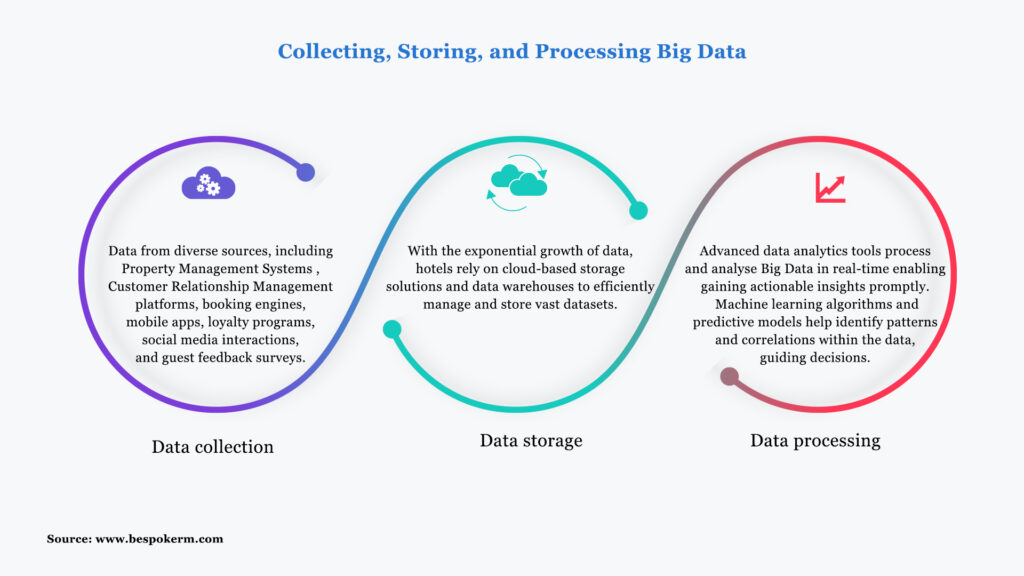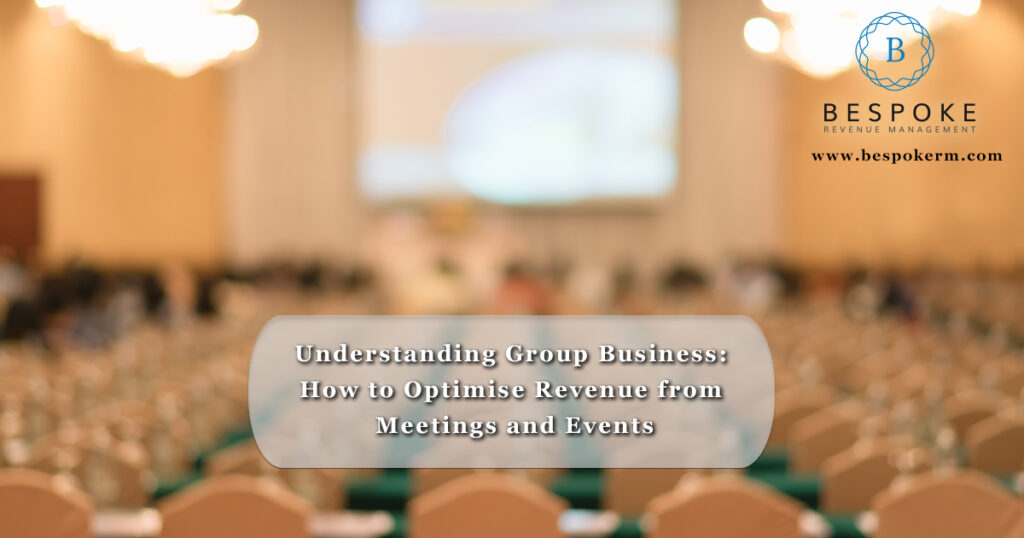
Introduction to Group Business Revenue Management
Group business plays a pivotal role in shaping the revenue streams of hotels, resorts, and event venues. This chapter looks into the fundamental concepts of group business revenue management, highlighting its significance and the challenges that arise in the pursuit of optimising revenue from meetings and events.
Definition of Group Business in the Hospitality Industry
Group business refers to the aggregation of bookings and reservations that encompass meetings, conferences, conventions, exhibitions, and other large-scale events held within the premises of hotels. These events, often organised by corporations, associations, or event planning companies, involve a considerable number of attendees who require accommodations, meeting spaces, and other related services. The nature of group business varies widely, spanning from corporate conferences to social gatherings like weddings and reunions.
Importance of Optimising Revenue from Meetings and Events
Maximising revenue from group bookings holds immense importance for hospitality entities seeking sustainable growth and profitability. Unlike individual travellers, group bookings offer a unique opportunity to generate substantial revenue in a concentrated timeframe. By effectively managing group business, hotels and venues can tap into a lucrative segment of the market and elevate their financial performance.
Additionally, successful group business revenue management extends beyond immediate financial gains. It fosters positive relationships with event planners and organisers, paving the way for repeat business and positive word-of-mouth recommendations. Such relationships contribute to a venue’s reputation and standing in the industry, ultimately attracting more high-value events.
Overview of Revenue Management Challenges Specific to Group Bookings
While the rewards of group business revenue management are enticing, the path to success is paved with specific challenges. Unlike individual reservations, group bookings demand intricate coordination, nuanced negotiations, and a deep understanding of the event’s dynamics. Balancing the desires of event planners with the need for profitability requires a delicate approach.
Negotiating rates that satisfy the budget constraints of event planners while ensuring the venue’s financial viability can be particularly challenging. Striking this equilibrium often involves customised pricing models, where transparent communication and flexibility become paramount.
Moreover, the intricacies of predicting room demand and allocating room blocks pose a considerable challenge. Overestimating or underestimating demand can lead to missed revenue opportunities or operational inefficiencies. The dynamics of group bookings can fluctuate, necessitating an agile approach to room allocation management.
In the subsequent chapters, we will explore strategies to navigate these challenges and unlock the potential of group business revenue management. By understanding the unique complexities of group bookings and implementing revenue management techniques tailored to this segment, hotels can enhance their financial performance while delivering exceptional experiences to event attendees.
Negotiating Rates with Event Planners
The success of optimising revenue from group bookings hinges on the art of negotiation—where the goals of event planners intersect with the financial objectives of hotels. In this chapter, we examine the dynamics of rate negotiation, exploring the critical role of event planners, the challenges of aligning rates with budgets, and strategies for achieving mutually beneficial outcomes while ensuring profitability.
Understanding the Role of Event Planners in the Group Booking Process
Event planners act as intermediaries between their clients and hospitality venues, orchestrating every facet of an event’s execution. They hold a pivotal role in the group booking process, as they are entrusted with curating seamless experiences that reflect their clients’ vision and objectives. Event planners are not only concerned with securing suitable accommodations but also negotiating favourable rates that align with their clients’ budgetary constraints.
Challenges in Negotiating Rates that Align with Event Budgets
Negotiating rates for group bookings is a delicate dance, as both parties aim to strike a balance between affordability and profitability. Event planners are tasked with delivering exceptional experiences while optimising expenses, a task that necessitates obtaining competitive rates for accommodations, meeting spaces, and related services. However, this can pose a challenge, as venues must also account for operational costs, overheads, and revenue targets.
Strategies for Effective Rate Negotiations While Maintaining Profitability
To navigate the intricacies of rate negotiations successfully, hotels must adopt strategies that foster cooperation and mutual benefit. Clear and transparent communication is paramount, as it lays the foundation for a collaborative negotiation process. Establishing trust and understanding with event planners can lead to more open discussions about rates and related services.
Flexibility in rate structures can also be a powerful strategy. Customising pricing models to the specific needs of each event, rather than adhering to a rigid pricing regime, allows venues to accommodate diverse budgets while preserving profitability. Offering bundled packages that include accommodations, meeting spaces, and additional services can provide value to event planners while maximising revenue streams.
Importance of Flexibility in Rate Structures to Cater to Various Event Types
Different events require different amenities and services. The importance of flexibility in rate structures cannot be overstated, as it allows venues to tailor their offerings to accommodate the distinct needs of various event types. Corporate conferences may demand advanced audiovisual equipment and business services, while social gatherings may prioritise catering and entertainment options. By customising rates based on these needs, venues can attract a wider range of events and expand their revenue potential.
In the dynamic landscape of group business, effective rate negotiation is a cornerstone of revenue optimisation. By understanding the motivations of event planners, employing strategic negotiation techniques, and offering flexible rate structures, hotels can foster partnerships that yield successful events and mutually beneficial financial outcomes. In the next chapter, we will explore the intricacies of optimising room block allocations to maximise occupancy and revenue.
Optimising Room Block Allocations
Efficiently managing room blocks for group bookings is a cornerstone of revenue optimisation in the hospitality industry. In this chapter, we delve into the concept of room block allocations, its importance, challenges related to predicting and managing room demand, techniques for maximising occupancy and revenue through optimised room block sizes, and the implementation of dynamic adjustments based on the dynamics of each event.
Exploring the Concept of Room Block Allocations and Its Significance
Room block allocations involve reserving a predetermined number of rooms within a hotel to accommodate the attendees of a group event. These allocations are crucial as they ensure that event attendees have access to accommodations, fostering convenience and a seamless experience. At the same time, they allow venues to streamline operations and allocate resources effectively.
Challenges in Predicting and Managing Room Demand for Group Bookings
Predicting room demand for group bookings presents a unique set of challenges. Unlike individual bookings, group sizes can fluctuate significantly, making it challenging to accurately estimate the number of rooms required. Overestimating room demand leads to vacant rooms, while underestimating it results in missed revenue opportunities and potential inconveniences for event attendees.
Techniques for Optimising Room Block Sizes to Maximise Occupancy and Revenue
To optimise room block allocations effectively, hotels can employ data-driven techniques. Historical data on past group events, alongside market trends and seasonal patterns, can provide valuable insights into demand fluctuations. Leveraging revenue management systems, hotels can dynamically adjust room block sizes to align with projected attendance, thereby maximising occupancy and revenue potential.
Implementing Dynamic Room Block Adjustments Based on Event Dynamics
The ability to adapt room block allocations in real-time based on event dynamics is a powerful strategy. For instance, if event registrations exceed expectations, venues can swiftly expand room block sizes to accommodate the increased demand. Conversely, if registrations are lower than anticipated, hotels can release unutilised rooms back into inventory, optimising resource allocation.
By embracing technology and leveraging predictive analytics, hotels can mitigate the challenges of managing room block allocations. The goal is to strike a balance between ensuring event attendees have convenient accommodations and capitalising on revenue opportunities. In the next chapter, we will explore revenue management techniques tailored to group bookings, enhancing revenue potential through strategic pricing strategies and demand forecasting.
Revenue Management Techniques for Group Bookings
Strategic revenue management is at the core of optimising revenue from group bookings within the hospitality industry. This chapter delves into essential revenue management techniques tailored to group business, encompassing demand forecasting, pricing strategies, and the critical role of data analytics in identifying revenue-enhancing opportunities.
Introduction to Revenue Management Strategies Applicable to Group Business
Revenue management strategies are a set of tools and methodologies designed to maximise revenue while optimising resource allocation. In the context of group bookings, these strategies are crucial for achieving financial goals while delivering value to event planners and attendees. Effective revenue management involves a holistic approach that factors in demand fluctuations, market trends, and customer preferences.
Utilising Demand Forecasting to Predict Group Booking Patterns
Demand forecasting is a cornerstone of revenue management, allowing hotels to anticipate booking patterns and allocate resources accordingly. By analysing historical data, market trends, and external factors that impact demand, venues can make informed decisions about room block sizes, pricing strategies, and staffing requirements. Accurate demand forecasting minimises the risk of overbooking or underutilisation of resources.
Applying Pricing Strategies Such as Discount Management and Length of Stay Optimisation
Pricing strategies play a pivotal role in revenue optimisation for group bookings. Hotels can employ dynamic pricing, offering different rates based on factors such as booking lead time, event size, and seasonality. Special discounts or incentives can be strategically offered to encourage early bookings or extended stays. Such techniques not only attract event planners but also lead to higher revenue per guest.
Length of stay optimisation is another pricing strategy that merits attention. Encouraging longer stays through attractive rates or additional perks can positively impact revenue. This approach aligns well with group bookings, as attendees often require accommodations for several days surrounding the event.
Importance of Data Analytics in Identifying Revenue-Enhancing Opportunities
Data analytics is the cornerstone of effective revenue management. Hotels can harness data from various sources, including past bookings, guest behaviour, and market trends, to uncover insights that inform strategic decisions. Advanced analytics tools allow venues to identify patterns, preferences, and untapped segments of the market. By leveraging data, establishments can tailor their offerings to meet the needs of different event types, enhancing revenue potential.
As the landscape of group business continues to evolve, implementing revenue management techniques becomes increasingly essential. By combining demand forecasting, strategic pricing, and data-driven insights, hotels can optimise their revenue streams while delivering exceptional experiences to event attendees. In the final chapter, we will explore the concept of maximising revenue through value-added services, cultivating long-term partnerships with event planners, and fostering a reputation for excellence in hosting group events.
Maximising Revenue through Value-Added Services
In the ever-evolving landscape of group business revenue management, the role of value-added services cannot be understated. This chapter dives into the potential of value-added offerings in enhancing revenue streams, exploring opportunities for group bookings, strategies for upselling and cross-selling, and the pivotal role of building long-term relationships with event planners.
Recognising the Potential of Value-Added Services in Boosting Revenue
Value-added services encompass a wide range of offerings beyond the core accommodations and event spaces. These services provide added convenience, comfort, and memorable experiences to event attendees, making them a lucrative avenue for revenue enhancement. Hotels that strategically integrate value-added services can differentiate themselves in a competitive market and command premium rates.
Identifying Value-Added Opportunities for Group Bookings (e.g., Catering, Amenities)
The scope of value-added services is vast, offering ample opportunities to cater to the unique needs of different events. For instance, catering services that offer tailored menus for events can contribute significantly to revenue. Additionally, amenities such as spa packages, transportation arrangements, and access to exclusive facilities can create an enticing package for event planners.
Understanding the preferences of the target market is key to identifying the most relevant value-added opportunities. These offerings should align with the goals and demographics of the event attendees, enhancing their overall experience.
Strategies for Upselling and Cross-Selling to Event Planners
Upselling and cross-selling are powerful techniques for increasing revenue from group bookings. Upselling involves offering premium versions of services, while cross-selling suggests related services that complement the event experience. For instance, when booking meeting spaces, event planners might be enticed by a premium package that includes audiovisual equipment and high-speed internet.
Effective communication is crucial in implementing upselling and cross-selling strategies. Event planners should be informed about the benefits of these services and how they can enhance the event experience for attendees. Bundling services together can also present a compelling value proposition.
Building Long-Term Relationships to Encourage Repeat Group Business
Cultivating long-term relationships with event planners is a strategic approach to maximising revenue. Establishing trust and consistently delivering exceptional experiences can lead to repeat business and referrals. Building a reputation for reliability, flexibility, and customer-centricity encourages event planners to choose the venue for their future events, generating sustained revenue over time.
Maintaining open lines of communication, seeking feedback, and continuously adapting offerings to changing needs are essential components of nurturing these relationships. The goal is to become a trusted partner in the event planning journey.
As we conclude this article, it’s evident that optimising revenue from group bookings requires a comprehensive approach that combines negotiation skills, strategic revenue management, and the delivery of exceptional experiences through value-added services. By understanding the nuances of group business revenue management, hotels can unlock the full potential of this segment and establish themselves as leaders in hosting successful meetings and events.
Conclusion: Mastering Group Business Revenue Management
Navigating the intricacies of group business revenue management demands a multifaceted approach that combines strategic thinking, dynamic adaptability, and a commitment to delivering exceptional experiences. In this article we have explored the essential elements of optimising revenue from meetings and events, shedding light on the unique challenges and opportunities that this segment presents.
From negotiating rates that align with event budgets to effectively managing room block allocations, we’ve delved into the core strategies that underpin successful group business revenue management. We’ve discussed the power of predictive analytics in demand forecasting, the art of pricing strategies that maximise revenue, and the pivotal role of data-driven insights.
Furthermore, we’ve explored how value-added services can transform an event into a memorable experience, enhancing revenue streams and fostering loyalty among event planners. The strategies of upselling and cross-selling have demonstrated their ability to not only drive revenue growth but also build lasting partnerships.
Ultimately, the key to mastering group business revenue management lies in understanding the diverse needs of event planners, embracing innovation, and nurturing relationships that extend beyond individual events. By adopting the insights and strategies presented in this guide, hotels can unlock the full potential of group bookings, solidifying their position as leaders in the art of optimising revenue from meetings and events. In a dynamic industry, the pursuit of excellence in group business revenue management is a journey that continues to evolve, offering boundless opportunities for growth, innovation, and success.



